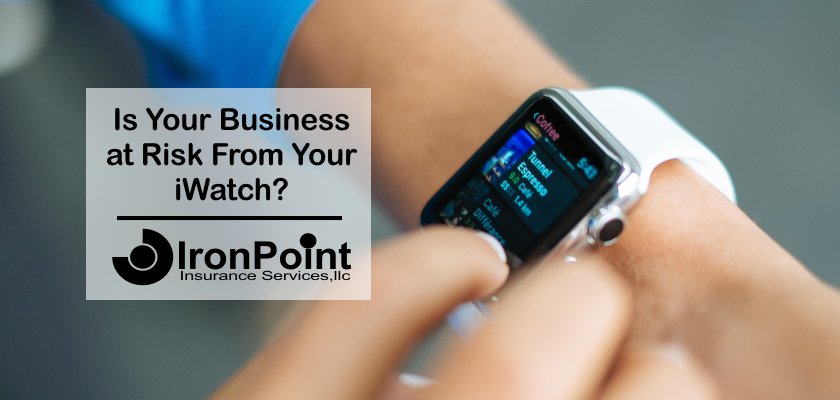Does the Apple iWatch Present a Business Risk?

Is the Apple iWatch a business risk? That may sound ridiculous on it’s face, but we in the insurance business see the world through a risk colored lens. Our vision seems to focus in on the inherent risk in anything new, different, or that creates change. The popularity of new wearable technologies like the Apple iWatch are no different.
These new devices have insurance folks wondering how business insurance risk is going to change? As wearable technologies continue to explode on the scene is this change inevitable, and has it already arrived?
Don’t get me wrong, wearable technology like the Apple iWatch are, for lack of a better word, cool. But the reality is that businesses that never before considered themselves tech savvy, are adopting new technologies to improve productivity without considering how these devices might introduce new risk.
It’s not the intention of this post to convince small business owners to pass on wearable technology. That is absolutely not the case, we encourage it.
Rather, our intention, is to make business owners aware of the threats, and assist in creating a strategy to mitigate new risk. If business owners understand these new exposures, it will only help protect your business against unforeseen hazards, allowing you to focus on the growth opportunities that connected technologies make possible.
How Does Wearable Technology Work?
The concept of wearable technology is elegant, taking the functionality of larger, more bulky devices and transferring their functionality to less obtrusive, wearable gear. The wearables that have gained the greatest amount of publicity are the watch, fitness trackers, and glasses. But there are several other wearables on the market, and being developed.
As with all technological marvels, it easier to explain how they work in concept, than to actually know how they work. Nonetheless, we’ll do our best.
Each wearable follows a similar framework, sensors capture impulses and translate them into actionable data that microprocessors extract, transform and load in a transmittable format. Finally, transmitters wirelessly send data to cloud storage for further processing and reporting.
The ability to create wearable technology has opened a wide range of applications for personal and commercial purposes. These applications range from health and fitness monitoring to employee monitoring and safety, people can expect tremendous expansion driven by the health care industry, the corporate sector and consumer demand.
In fact, health care and fitness is the earliest emerging market for wearables. According to PwC, over 80% of consumers said an important benefit of wearable tech is its potential to make healthcare more convenient. In the same survey 68% of those asked said they would wear employer-provided wearables streaming anonymous data to an information pool in exchange for lower health insurance costs.
Want to know just how popular wearable technology is getting , check out the video below:
What Are the Business Insurance Risks?
The risks to your business are not completely obvious, but that doesn’t mean they aren’t very real. You need to confirm you’re business insurance can protect you for the new risk being introduced should your business want to use wearable technology.
The risks associated with wearable technology breakdown into three main categories:
- Cyber liability
- General liability
- Professional liability (or Errors & Omissions)
Let’s break these down one at a time.
Protect Against Cyber Risks
Let’s first look at risk associated with cyber liability insurance. If your business is using wearable technology, and the data transmitted via the wearable gear is not properly secured, you might be creating an open door for hackers to steal valuable consumer data. Such a data breach can expose your business to legal action, costly fines, and even damaged reputation.
Wearable devices should be engineered with data security in mind. Manufacturers have the burden of proof to show that data detected by their device was properly safeguarded. Consider the following strategies to help ensure proper data protection:
- Custom security level settings for the user;
- Remote erase feature;
- Bluetooth encryption;
- Encrypt critical data elements such as user ID, passwords and PIN;
- Secure data with multiple OSs in the cloud.
Protect Against General Liability Risks
The exposure wearable present for general liability insurance exposure is not as clear, but a malfunctioning device might cause injury, illness and possibly death if it were to malfunction. If you’re business uses wearable technology to manufacture new products, you may be subject to product liability suits if they malfunction and cause injury or other damages.
Wearables manufacturers need to understand and mitigate the risk of a product liability claim that may be filed as a result of their device failing. Consider these strategies to help protect against bodily injury risks:
- Conduct extensive testing;
- Conduct robust hazard analysis;
- Plan for mitigation;
- Evaluate awareness of and adherence to key standards;
- Build in cyber-security;
- Develop clear safety and use instructions.
Protect Against Technology Errors & Omissions
If your company develops wearables technologies, or application for such devices, you may be held liable for economic loss should the device or program fail. This makes having the right technology professional liability insurance important.
For certain economic losses caused by the failure of a device to work as intended, manufacturers may face technology professional liabilities. In addition to the strategies mentioned above for bodily injury risk (which may also help for this category), companies should evaluate the following customer contract provisions to manage this exposure:
- Limitation of liability;
- Damage caps;
- Disclaimer/Limitation of warranties;
- Integration;
- Contractual risk transfer and defense/indemnity provisions.
The bottom line
Technology grows at an alarming pace, and it takes a nimble business insurance market to keep pace with the proper coverage. If you’re using wearables in your business, or are considering a new technology, consult your insurance agent, or risk management professional to assess that you have the proper insurance protection before you introduce new risk … regardless of how cool or innovative it may be.
Image Source: Crew

Compare Business Quotes
Looking for business insurance? Click “Start a Quote” to compare Business Owner’s Policy and Worker’s Compensation rates. Ready to purchase? Choose “Quote & Buy Online” to buy directly online.
Rather speak with an insurance agent?
1-877-334-7646